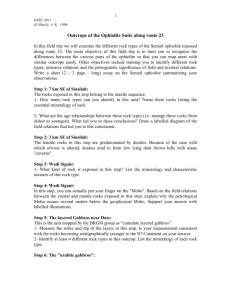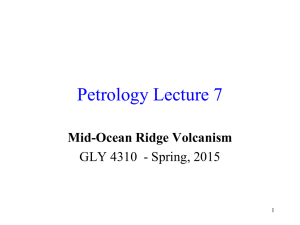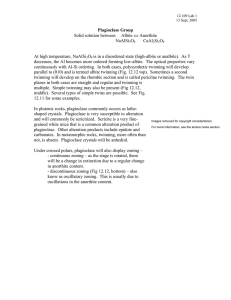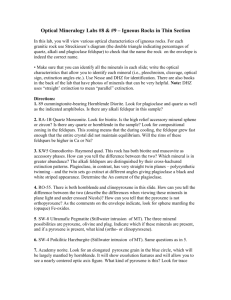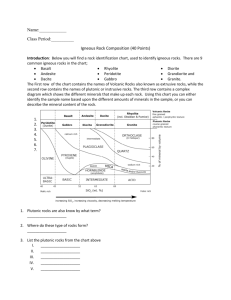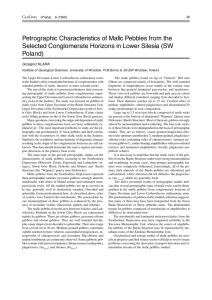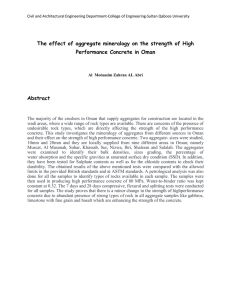Document 14104589
advertisement
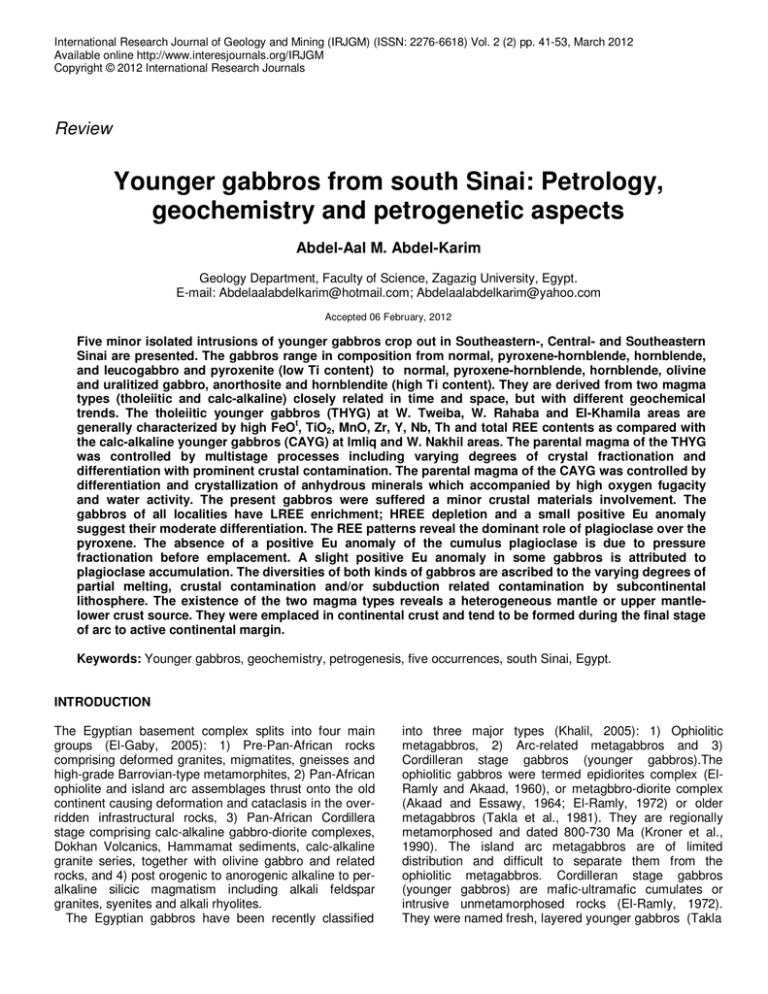
International Research Journal of Geology and Mining (IRJGM) (ISSN: 2276-6618) Vol. 2 (2) pp. 41-53, March 2012 Available online http://www.interesjournals.org/IRJGM Copyright © 2012 International Research Journals Review Younger gabbros from south Sinai: Petrology, geochemistry and petrogenetic aspects Abdel-Aal M. Abdel-Karim Geology Department, Faculty of Science, Zagazig University, Egypt. E-mail: Abdelaalabdelkarim@hotmail.com; Abdelaalabdelkarim@yahoo.com Accepted 06 February, 2012 Five minor isolated intrusions of younger gabbros crop out in Southeastern-, Central- and Southeastern Sinai are presented. The gabbros range in composition from normal, pyroxene-hornblende, hornblende, and leucogabbro and pyroxenite (low Ti content) to normal, pyroxene-hornblende, hornblende, olivine and uralitized gabbro, anorthosite and hornblendite (high Ti content). They are derived from two magma types (tholeiitic and calc-alkaline) closely related in time and space, but with different geochemical trends. The tholeiitic younger gabbros (THYG) at W. Tweiba, W. Rahaba and El-Khamila areas are generally characterized by high FeOt, TiO2, MnO, Zr, Y, Nb, Th and total REE contents as compared with the calc-alkaline younger gabbros (CAYG) at Imliq and W. Nakhil areas. The parental magma of the THYG was controlled by multistage processes including varying degrees of crystal fractionation and differentiation with prominent crustal contamination. The parental magma of the CAYG was controlled by differentiation and crystallization of anhydrous minerals which accompanied by high oxygen fugacity and water activity. The present gabbros were suffered a minor crustal materials involvement. The gabbros of all localities have LREE enrichment; HREE depletion and a small positive Eu anomaly suggest their moderate differentiation. The REE patterns reveal the dominant role of plagioclase over the pyroxene. The absence of a positive Eu anomaly of the cumulus plagioclase is due to pressure fractionation before emplacement. A slight positive Eu anomaly in some gabbros is attributed to plagioclase accumulation. The diversities of both kinds of gabbros are ascribed to the varying degrees of partial melting, crustal contamination and/or subduction related contamination by subcontinental lithosphere. The existence of the two magma types reveals a heterogeneous mantle or upper mantlelower crust source. They were emplaced in continental crust and tend to be formed during the final stage of arc to active continental margin. Keywords: Younger gabbros, geochemistry, petrogenesis, five occurrences, south Sinai, Egypt. INTRODUCTION The Egyptian basement complex splits into four main groups (El-Gaby, 2005): 1) Pre-Pan-African rocks comprising deformed granites, migmatites, gneisses and high-grade Barrovian-type metamorphites, 2) Pan-African ophiolite and island arc assemblages thrust onto the old continent causing deformation and cataclasis in the overridden infrastructural rocks, 3) Pan-African Cordillera stage comprising calc-alkaline gabbro-diorite complexes, Dokhan Volcanics, Hammamat sediments, calc-alkaline granite series, together with olivine gabbro and related rocks, and 4) post orogenic to anorogenic alkaline to peralkaline silicic magmatism including alkali feldspar granites, syenites and alkali rhyolites. The Egyptian gabbros have been recently classified into three major types (Khalil, 2005): 1) Ophiolitic metagabbros, 2) Arc-related metagabbros and 3) Cordilleran stage gabbros (younger gabbros).The ophiolitic gabbros were termed epidiorites complex (ElRamly and Akaad, 1960), or metagbbro-diorite complex (Akaad and Essawy, 1964; El-Ramly, 1972) or older metagabbros (Takla et al., 1981). They are regionally metamorphosed and dated 800-730 Ma (Kroner et al., 1990). The island arc metagabbros are of limited distribution and difficult to separate them from the ophiolitic metagabbros. Cordilleran stage gabbros (younger gabbros) are mafic-ultramafic cumulates or intrusive unmetamorphosed rocks (El-Ramly, 1972). They were named fresh, layered younger gabbros (Takla 42 Int. Res. J. Geol. Min. Figure 1. Location map showing the distribution of the studied younger gabbros in south Sinai. et al., 1981), and considered to be post-tectonic intrusions (655-570 Ma), equivalent to the Andean type calc-alkaline sequence (El-Gaby et al., 1988) or olivine gabbro and related rocks (El-Gaby, 2005). Gabbroic rocks in Sinai crop out as numerous small masses. El-Metwally (1997) suggested that the Sinai mafic-ultramafic rocks (metagabbro-diorite complex) were intruded in an active continental margin above subduction zone. They were metamorphosed into the greenschist, and locally in the lower amphibolite facies. Basta (1998) concluded that the Sinai gabbros (including Wateir) were crystallized from a hydrous calc-alkaline magma, possibly formed in an active continental margin environment. Kroner et al. (1990) determined the ages of metagabbrometabasites complex and metadiorite from Taba (nearby 207 209 Tweiba) and Aqaba using Pb/ Pb method and obtained ages ranging from 640 to 641±6 Ma. AbdelKarim (1995) concluded that the K-Ar age dating of the hornblendes and biotites separated from metagabbrodiorite complex from Wadi Baba, SW Sinai gave 794+30 to 667+25 Ma age. Takla et al. (2001) considered the ophiolitic ultramafics of Kabr El-Bonya of SE Sinai (Abdel-Khalek et al., 1997), layered ophiolitic metagabbro-diorite of El-Melhega (Shimron, 1981; AbdelKhalek et al., 1997) and the metagabbro-diorite of Feiran (Higazy and El-Gammal, 1990), Nisreen (El Tokhi and Katta, 1993) and Saal areas (El-Metwally, 1997) all together as intrusive younger gabbros. Tweiba gabbros were previously described as metagabbro-diorite complex of tholeiitic affinity, intruded in a continental within-plate tectonic setting and metamorphosed into the middle amphibolite facies (Abu El-Enen, 1995). Takla et al. (1991) concluded that the hornblende gabbro of Wadi Watir (including Wadi Nakhil) was affiliated to the younger gabbros. The gabbroic rocks of Rahaba were previously described as mafic-ultramafics, composed of pyroxene metagabbro in the inner part of the pluton, and hornblendite in the periphery or the sheared mylonitic zones (Soliman, 1997). El-Metwally (1986) studied the rocks crop out in the El-Sammraa (Imliq) and Wadi Seih (El-Khamila) and considered them as two maficultramafic intrusions. The former intrusion composed of layered wehrlite, clinopyroxenite and gabbros, while the second one comprised cumulate gabbros, pyroxenites and anorthosites, both of them are considered as a nonophiolitic assemblage. On the other hand, Mehanna et al., (2004) concluded that the mafic-ultramafic rocks of Imliq area represented by serpentinized peridotites and metagabbros belong to an ophiolite assemblage. Petrographic and chemical characterization of Fe-Ti oxides and sulfides hosted in the present mafic intrusions were given by Abdel-Karim (2009). General geology and petrography The studied gabbroic rocks of Sinai occur in three main provinces: Southeastern Sinai (Tweiba and Nakhil), Central Sinai (Rahaba) and Southeastern Sinai (Imliq and El-Khamila) (Figure 1). The Tweiba gabbros form a small elongated mass, 2 which occupies an area of about 3.2 km . It exhibits a sharp intrusive contact against the adjacent granitoid rocks (Figure 2a) and schist. The rock is medium grained with massive and equi-dimensional textures. It comprises pyroxene hornblende gabbros in the inner part of the intrusion, and hornblende gabbros in the periphery. Petrographically, the hornblende gabbros are made up of Abdel-Karim 43 Figure 2. Field photos and photomicrographs showing: a) sharp contact between gabbro and granite, W. Toweiba, b) partial alteration of oxyhornblende to biotite and opaques, Hornblende gabbro, W. Tweiba, c) inclusion of plagioclase and opaques in pyroxene, Normal gabbro, W. Nakhil, d) abundance of cumulus hornblende megacrysts , Hornblendite, W. Rahaba, e) rhythmic layering of gabbro, Imliq, f) dominant cumulus diopside, Clinopyroxenite, Imliq, g) weathering surface of gabbro, El-Khamila; h) olivine is replaced by pyroxene or mantled by amphibole, Olivine gabbro, El-Khamila. cumulus hornblende and plagioclase, with subordinate amounts of biotite, quartz with accessory Fe oxides, sulfides and apatite. The hornblende is fresh, partly altered to biotite and iron oxides (Figure 2b) or recrystallized to fine grained aggregates of the same minerals. The pyroxene hornblende gabbros are 44 Int. Res. J. Geol. Min. composed essentially of cumulus hornblende, pyroxene and plagioclase with subordinate amounts of quartz, biotite, and accessory magnetite, ilmenite and apatite. Wadi Nakhil gabbros form an oval-shape mass (with an area of about 1.0 km2). The mass occurs as large xenoliths or as roof pendants within the neighboring Younger Granites. The rock is fresh, massive and coarse to rarely medium grained and comprises pyroxenehornblende gabbros and normal gabbros. Petrographically, the hornblende gabbros are essentially composed of cumulus plagioclase (An50-56) and hornblende with subordinate amounts of intercumulus augite. Quartz, biotite, chlorite apatite and opaques are accessories. The normal gabbros are essentially composed of cumulus plagioclase (An52-60), augite and intercumulus hornblende with subordinate amounts of biotite. Accessories are quartz, chlorite, apatite and opaques. Augite is partly or totally enclosed variable-size plagioclase forming ophitic and subophitic textures (Figure 2c). The pyroxene-hornblende gabbros are essentially composed of cumulus plagioclase (An50-55) and pyroxene with subordinate amounts of hornblende.Accessories are apatite, magnetite and titanomagnetite. Wadi Rahaba gabbros occur as a small elongate mass (about 4.2 km2). It comprises uralitized gabbros and hornblendites. The hornblendites form dyke-like bodies cutting across the uralitized gabbros with sharp contacts and extend for about 15 m long and 2.5 widths. Appinitic gabbro variety is also recorded. The Rahaba gabbros display a sharp intrusive contact against and are located within the adjacent tonalite-granodiorite association. The rock is coarse grained with massive and less common schistose textures. Petrographically, the uralitized gabbros are essentially composed of cumulus augite and hypersthene and plagioclase (An54-59) with subordinate amounts of pigeonite, quartz and accessory apatite, opaques and chlorite. The hornblendites are mainly composed of cumulus hornblende and plagioclase (An5257) with minor pyroxene, biotite, quartz and accessories apatite and iron oxides, as well as chlorite as a retrograde mineral. Hornblende forms sheared megacrysts, usually embedded in a schistose groundmass of hornblende, plagioclase, opaques and titanite (Figure 2d). Imliq gabbros form an irregular elongated mass (~ 50 km2). The mass intrudes calc-alkaline older granitoids and is intruded by alkaline younger granites. Imliq gabbros mainly comprise pyroxene gabbro and leucogabbro. Lenses and dyke-like bodies of clinopyroxenite (10-25 m long and 1.0-2.5 m width) are observed. It is observed that anorthosite is intruding the gabbro mass. Imliq gabbros are intersected by dykeswarms of varying composition and styles. Rhythmic layers (a few cm thick) are recorded (Figure 2e). The rock is fresh, medium to very coarse-grained. Petrographically, the normal gabbros are basically composed of cumulus plagioclase, pyroxene and hornblende. The accessory phase includes quartz, chlorite, titanomagnetite, apatite and ilmenite. Leucogabbros are essentially composed of cumulus augite, hornblende and intercumulus plagioclase with accessory quartz, chlorite, magnetite, ilmenite and apatite. Ophitic and subophitic intergrowths of plagioclase and hornblende are common. Clinopyroxenites are fundamentally composed of cumulus diopside (Figure. 2f) and its alteration products together with minor postcumulus plagioclase (An85-88). The accessories are magnetite, ilmenite, titanite and chalcopyrite. El-Khamila gabbros occur as an irregular mass (~ 13 2 km ). The mass intrudes calc-alkaline older granitoids with a sharp intrusive contact. It sometimes exhibits boulders weathering (Figure 2g). It mainly comprises olivine pyroxene, pyroxene gabbros and less common anorthosite. In places, El-Khamila gabbros exhibit small rhythmic layers (a few cm thick). Igneous lamination is associated with layering. The rock is hard, medium to very coarsegrained, grey to dark green in color. Petrographically, the olivine gabbros are essentially composed of cumulus bytownite (An65-73), augite and less common olivine. Olivine is replaced by pyroxene or mantled by amphibole (Figure 2h). Hypersthene, magnetite, and ilmenite are accessories. Chlorite is the main secondary mineral. The normal gabbros are made up of cumulus labradorite (An52-58) and augite with minor intercumulus hornblende and pigeonite. Magnetite, apatite, and titanite are the main accessories. The anorthosites consist of cumulus plagioclase (An75-85), and minor uralitized diopside. Magnetite and ilmenite are accessories, whereas chlorite and epidote are secondary minerals. Geochemistry The geochemistry of the studied younger gabbros is based on twenty-four representative samples. The trace elements were analyzed by using XRF spectrometer. The content of eleven REEs was estimated by ICP Analysis. The analysis has been carried out in the Institute of Mineralogy and crystallography, Vienna University. The analytical results are presented in Table 1. On the basis of the geochemistry, the Younger Gabbros of Egypt reveal three main concepts: i) Intrusive rocks of calc-alkaline character and belong to an island arc setting (Takla et al., 1981, Salem et al., 1992, El-Mansey, 1996) ii) Calc-alkaline to tholeiitic affinity and emplaced into island arc (Sadek, 1994, Moghazi, 1994, Abdel-Karim et al., 1997, Heikal et al., 1998). iii) Calc-alkaline and tholeiitic compositions denote typical early intrusions during the transition from arc to continental magmatic activity and have generated from two magma sources (El-Metwally, 1992 and 1997, El- Abdel-Karim 45 Table 1. Results of the major, trace and REEs of some gabbros from south Sinai, Egypt SiO2 Al2O3 Fe2O3 MgO CaO Na2O K2O TiO2 P2O5 MnO LOI Total Cr Ni Ba Th U Nb Sr Zr Y As Co Pb Sc W Zn La Ce Pr Nd Sm Eu Gd Tb Dy Ho Er Tm Yb Lu ∑ Tholeiitic younger gabbros (THYG) Wadi Rahaba Hornblendite Uralitized gabbro 10 11 12 13 Rh2 Rh20 Rh7 Rh70 50.47 50.73 50.88 51.20 15.05 14.85 14.63 14.58 12.46 12.08 12.39 11.87 7.11 6.58 6.75 7.12 9.85 10.11 10.16 9.94 2.13 1.97 1.94 1.98 0.58 0.60 0.61 0.59 1.08 1.03 1.04 1.06 0.23 0.24 0.24 0.25 0.25 0.23 0.23 0.25 0.45 0.98 0.68 0.27 99.66 99.40 99.55 99.58 215 228 229 233 45 55 45 51 278 281 263 257 3.1 2.8 2.2 1.2 1.2 1.8 1.1 2.4 7.4 7.5 7.3 7.9 450 525 486 501 71 90 81 74 22 21 26 29 1.5 3 3 2 52 34 41 44 11 8 12 15 55 23 47 51 2.7 3.9 3.3 4.1 48 112 95 102 18.60 20.15 24.30 40.50 3.60 6.00 19.20 30.00 4.00 6.40 1.48 2.22 5.72 3.12 0.55 0.65 3.52 3.84 0.77 0.84 2.00 2.40 0.30 0.39 2.20 2.40 0.30 0.36 88.54 119.2 7 W. Tweiba Px-Hbl gabbro 1-14 Tw5 50.53 16.62 12.59 5.11 8.29 2.95 0.91 1.49 0.28 0.22 1.00 99.45 103 12 281 3.0 0.5 5.6 383 73 21 5.3 30 8 47 0.0 94 15.50 20.25 2.40 12.00 3.80 1.90 2.60 0.54 2.56 0.49 1.20 0.21 1.40 0.24 65.09 2-15 Tw50 50.74 16.43 12.94 5.09 8.31 2.94 0.93 1.45 0.29 0.23 0.51 99.86 80 15 388 2.9 1.1 4.3 312 62 22 4.2 33 8 49 0.6 99 - 3-16 Tw51 51.06 16.58 12.48 5.14 8.24 2.88 0.89 1.51 0.27 0.24 0.64 99.93 109 13 265 3.2 0.8 4.4 397 77 17 1.2 20 4 53 0.3 74 - Hbl gabbro El-Khamila Oliv gabbro Anorthosite Gabbro 4-17 Tw4 54.10 15.12 11.62 4.57 7.11 2.60 1.38 1.58 0.37 0.19 1.60 99.82 72 9 342 3.8 0.4 9.1 295 64 15 1.9 28 10 46 0.8 87 17.05 24.30 3.25 15.60 5.20 2.00 3.12 0.65 3.52 0.63 1.80 0.27 2.00 0.30 79.69 19 SS8 44.66 15.35 17.08 6.70 8.44 2.54 1.10 1.78 0.64 0.27 1.05 99.61 125 50 91 2.6 1.1 3.7 696 70 5 2.5 37 5 23 1.8 38 9.30 13.67 1.98 7.20 1.30 0.56 1.09 0.12 0.48 0.11 0.48 0.07 040 0.06 36.82 21 SS3 45.99 17.13 15.14 7.03 9.19 2.21 0.79 1.49 0.17 0.15 0.65 99.94 - 23 SS3a 44.99 16.13 16.14 7.03 9.19 2.21 0.79 1.40 0.17 0.15 0.65 99.83 73 29 291 2.9 3.6 6.9 802 62 16 2 45 9 20 1.3 114 16.12 29.16 3.84 12.00 1.60 0.59 1.17 0.17 0.83 0.15 0.46 0.08 0.52 0.08 66.77 5-18 Tw40 54.80 15.10 11.18 4.35 7.13 2.54 1.39 1.52 0.39 0.18 0.99 99.97 88 8 354 4.2 0.3 10.5 302 69 53 2.1 27 10 48 0.7 90 - 20 SS80 44.87 15.54 16.12 6.02 8.43 2.51 1.04 1.69 0.59 0.31 0.95 99.07 115 55 102 2.1 2.8 3.8 681 65 6 1.4 34 5 25 1.5 42 - 22 SS30 45.15 16.50 15.77 7.31 9.32 2.17 0.83 1.43 0.18 0.15 0.63 99.74 - 24 SS8a 45.66 15.35 17.58 5.70 8.44 2.54 1.10 1.58 0.64 0.27 0.55 99.41 77 36 312 4.0 4.2 7.5 745 71 2 4 30 6 23 2.1 18 - 46 Int. Res. J. Geol. Min. Table 1. Continue……. SiO2 Al2O3 Fe2O3 MgO CaO Na2O K2O TiO2 P2O5 MnO LOI Total Cr Ni Ba Th U Nb Sr Zr Y As Co Pb Sc W Zn La Ce Pr Nd Sm Eu Gd Tb Dy Ho Er Tm Yb Lu ∑ Calc-alkaline younger gabbros (CAYG) Imliq ClinoGab. Leucogabbro pyroexenite 14-1 15-2 16-3 17-4 18-5 Be27 Be22 Be25 Be27 Be22 a b b a 51.39 51.45 50.91 52.08 52.42 19.31 16.45 17.86 18.51 16.40 7.71 8.24 7.96 7.84 8.20 6.37 7.92 7.13 7.05 7.89 8.17 10.24 9.28 8.85 9.39 3.73 2.78 3.30 2.98 2.87 1.04 1.00 1.04 0.99 1.03 0.85 0.49 0.66 0.67 0.47 0.04 0.05 0.09 0.09 0.03 0.14 0.16 0.15 0.15 0.15 0.95 1.02 1.17 0.55 0.70 99.70 99.80 99.52 99.76 99.55 110 155 108 111 149 46 55 44 39 52 406 199 425 242 1 84 1.8 0.8 1.6 2.3 0.7 4 2.8 4.2 4.4 3.2 4.9 3.7 5.1 4.5 3.6 746 644 734 781 633 42 11 57 43 30 14 7 15 13 7 0 0 0 0 0 28 44 30 25 39 9 6 7 8 7 28 41 29 26 42 2.9 2.7 3.1 1.5 2.5 71 135 71 111 211 8.40 5.60 8.06 23.50 13.77 26.73 2.04 3.24 2.40 7.80 16.80 14.40 2.60 1.80 2.80 0.59 1.12 1.04 1.69 1.56 2.47 0.26 0.43 0.30 2.30 1.66 1.38 0.35 0.29 0.43 0.94 1.26 1.20 0.16 0.20 0.18 0.90 1.24 1.08 0.16 0.10 0.17 58.96 37.29 67.25 W. Nakhil Px-Hbl gabbro 6 7 Wt9 Wt90 8 Wt30 9 Wt3 49.58 18.41 7.91 6.69 10.00 2.38 0.82 0.53 0.12 0.12 3.27 99.83 83 44 269 2.6 2.6 5.5 724 77 12 0.7 43 11 24 1.8 71 16.43 26.73 3.72 16.80 2.40 0.84 2.34 0.35 1.82 0.33 1.00 0.14 1.02 0.14 74.06 49.61 18.32 8.11 6.71 10.02 2.32 0.78 0.55 0.12 0.11 3.02 99.67 141 39 250 2.3 0.9 5.1 694 77 10 0.3 46 2 21 1.1 72 - 50.05 18.28 8.21 6.45 9.84 2.48 0.87 0.58 0.10 0.13 2.44 99.43 88 69 195 2.8 1.6 5.9 712 77 13 0 23 10 20 1.6 46 13.95 21.06 2.52 15.00 4.20 1.12 3.90 0.06 2.88 0.60 1.60 0.23 1.56 0.22 68.90 49.71 18.44 7.69 6.59 9.97 2.34 0.81 0.54 0.11 0.13 3.24 99.57 78 58 275 3.1 2.1 7.1 781 81 14 0.9 55 18 19 2.1 66 - Gabbro Abdel-Karim 47 Figure 3. Variation diagrams showing the chemical classification of the studied gabbros, a) b) Alkalis versus silica diagram adapted by Wilson (1989); c) FeOT/MgO versus SiO2 of Miyashiro (1974); d) AFM diagram of Irvine and Baragar (1971); e) FeO+Fe2O3-Al2O3-MgO diagram of Jensen (1976). Sheshtawi et al., 1994). On the other hand, El-Mahallawi (1996) mentioned that gabbroic rocks of El-Ginena El Gharbia exhibit a definite calc-alkaline nature and have a transitional character from uncontaminated within plate basalts to crustal contaminated mafic rocks of active continental margin indicating their derivation from a mantle source which experienced subduction. The analyzed samples of the present younger gabbros display two different trends with tholeiitic and calcalkaline affinities and their averages chemical composition (Table 1) are analogous to those mentioned by El-Metwally (1997) and Moghazi (1994). The calcalkaline younger gabbros (CAYG) are generally higher in SiO2, CaO, Ni and Sr, and lower in FeOt, TiO2, Al2O3, MnO, Zr, Y, Sc and total REE content compared to the tholeiitic younger gabbros (THYG).It is notable that the THYG are exposed at Wadi Rahaba, Wadi Tweiba and El-Khamila. While the CAYG are represented by those exposed at Imliq and Wadi Nakhil. On SiO2 versus alkalis diagram, all the analyzed gabbroic rocks plot mainly in the gabbro field with minor gabbro-diorite field (Figure 3a). Geochemical Classification and Magma Type: The analyzed samples reveal again two different trends for the present gabbroic rocks tholeiitic and calc-alkaline. The analyzed samples of Imliq and W. Nakhil areas (CAYG) display calc-alkaline nature, while those of Wadi Rahaba, Wadi Tweiba and El-Khamila areas (THYG) show tholeiitic tendency (Figure 3b,c,d). The same feature was concluded for the younger gabbros in Sinai (El-Metwally, 1986, 1992 and 1997, Moghazi, 1994, Heikal et al., 1998). Good correlation of the major and trace elements against FeOT/MgO ratio are also evident on the Harker diagrams (Figure 4) which used to differentiate between the THYG and CAYG as well as to explain the mobility and some genetic relations. This figureure reveals a compositional gap amongst the gabbroic rocks related to their tholeiitic and calc-alkaline tendencies. The THYG are characterized by increasing FeOT/MgO ratio with increasing TiO2, MnO, Na2O, K2O, P2O5, Y, Th and As and decreasing Al2O3, CaO, MgO, Cr, Ni, Co, Zn contents. The noticeable scatter (especially Zr, Y) can be explained by varying amounts of crystal fractionation and 48 Int. Res. J. Geol. Min. Figure 4. Harker variation diagrams for major (Wt.%) and trace elements (ppm) versus FeOT/MgO. differentiation. Apart the scattered distribution, the contents of TiO2, Zr and Th increase, while those of Al2O3, CaO, MgO, Cr and Zn decrease with increasing FeOT/MgO ratio in the CAYG. These features indicate the role of fractionation of clinopyroxene, plagioclase, olivine and Fe-Ti oxides for present gabbros. Sr behaves incompatibility with differentiation suggesting plagioclase accumulation for the tholeiitic-suites but unlikely in calcalkaline ones (DeBari, 1994). Crustal Contamination and Tectonic Setting The role of crustal contamination must be considered in all intraplate magmatic environments (Wilson, 1989). Some elemental ratios (e.g., Y/Nb, Nb/Zr and La/Zr) are utilized as parameters for crustal contamination. Weaver et al. (1972) and Lippard (1973) reported that if these ratios are low or constant throughout the rocks, then the crustal contamination is unlikely to have occurred. In the CAYG of W. Nakhil and Imliq, the above mentioned ratios are nearly constant or of narrow range values (4.5-10.0 Y/Nb, 0.02-0.05 Nb/Zr and 0.15-0.22 La/Zr). A feature indicates that crustal contamination played a minor role throughout these gabbros. On the other hand, the elemental ratios Y/Nb (2.1-16.9), Nb/Zr (0.01-0.11) and La/Zr (0.21-0.55) are variable throughout the THYG of W. Tweiba, W. Rahaba and El-Khamila which indicate dominant crustal contamination upon these rocks. Moreover, the existence of more prominent negative Nb-anomalies of the CAYG with respect to that of the THYG may have been reflected a more crustal contamination of the former gabbros, because the LIL elements are typically enriched compared with Nb in the continental crust (Taylor and McLennan, 1985). The plots of the investigated gabbros fall in the continental field on the Zr-Zr/Y diagram of Pearce (1983) t (Figure 5a). On the FeO -MgO-Al2O3 diagrams of Pearce et al. (1977) (Figure 5b), the CAYG lie within the island arc (or volcanic arc) and active continental margin field, whereas the THYG fall in the continental field. This feature suggests a transitional regime towards the intraplate tectonic setting. The same conclusion was concluded for the younger gabbros in Sinai (El-Metwally, 1997). However, samples lie in the orogenic field indicating that these rocks were generated originally by varying degree of crystal fractionation and differentiation of parental magma derived from upper mantle –lower crust materials (Jubeli and Heikal, 1994, Heikal et al., 1998). Abdel-Karim 49 t Figure 5. a Zr/Y vs. Zr diagram of Pearce (1983)for the studied gabbros; b)FeO -MgO-Al2O3 diagram of Pearce et al.(1977), 1: Spreading center island, 2: orogenic (island arc and active continental margin), 3: Oceanic ridge and floor, 4: Oceanic island, 5: continent. REEs The chondrite normalized REE patterns (Table 1, Figure 6) show that present gabbros are enriched in REE relative to the chondritic abundances, and enriched in LREE (La-Sm) relative to HREE (Gd-Yb). Generally, they have moderately fractionated REE patterns. The patterns indicate that there are differences between the tholeiitic (THYG) and calc-alkaline younger gabbros (CAYG). The THYG have a wider range of REE with respect to that of the CAYG. The overall abundance of REE varies from 1 to 70 times chondritic in the THYG compared with that of the CAYG (3-50 times) (Figure 6a,b). The THYG have moderately fractionated REE pattern where (Ce/Yb)n varies from 2.7 to 13.8 and (La/Lu)n varies from 5.4 to 20.8. The REE patterns of both gabbros from W. Rahaba and Tweiba are rather similar. El-Khamila gabbros are characterized by more depleted moderate REE [(Sm/Yb)n= 3.1] and HREE [(Gd/Lu)n= 1.8-2.0] abundance with respect to that from both W. Rahaba and W. Tweiba [(Sm/Yb)n= 1.8-2.7] and HREE [(Gd/Lu)n= 1.0-2.2] (Figure 6a) probably indicate their less fractionalization. Moreover, a progressive increase in REE abundance of the present THYG (as well as their fractionation trend) form El-Khamila through W. Tweiba to W. Rahaba is recorded. The CAYG have moderately fractionated REE pattern where (Ce/Yb)n varies from 3.3 to 6.5 and (La/Lu)n varies from 4.7 to 11.0 (Figure 6b). The REE patterns of both gabbros from W. Nakhil and Imliq are rather similar. However, a progressive increase in REE abundance of the present CAYG (as well as their fractionation trend) form Imliq to W. Nakhil is recorded. A slight positive Eu anomaly is observed in some samples from the studied gabbros of all areas due to plagioclase accumulation. The normalized REE patterns of the average values of all studied gabbros (Figure 6c) exhibits a progressive evolution from El-Khamila through Imliq, W. Nakhil, W. Tweiba to W. Rahaba suggesting their fractionation trend. The averages of studied gabbros are plotted on MORBnormalized patterns (Figure 6d) compared with basalts from different sources (Sun, 1980). On this diagram, the arc related environment is effectively distinguishable from the within plate setting on the basis of a diagnostic Nb, Ce and Ti trough (Pearce, 1983, Tepper, 1996, etc.) reflect the so-called a subduction zone component. The diagram also has the advantage of illustrating -at a glance- the degree of arc maturity. From figure (6d) it is interesting to note that the present suites occupy the intermediate portion between the arc and continental margin basalts and seem to represent a transitional stage between a continental island arc and a thick continental margin as well as reflect a thin continental margin. However, the CAYG are characterized by higher U and Sr and lower Nb, Y and Tb contents with respect to the THYG probably due to their less affect by subduction and transition to continental margin setting. DISCUSSION AND PETROGENETIC ASPECTS In terms of petrogenesis it is interesting to speculate on the process (es) which explain the observed variation throughout the suits. In spite of the investigated THYG and CAYG are closely related in space and time, they do not form a single comagmatic suite and may have been intruded over a wide period of time. Similar conclusion was given for the younger gabbros in Sinai (El-Metwally, 1997). Nevertheless, diversities in chemistry between both varieties are mentioned above. The ratios between incompatible elements (e.g., Zr/Nb, Zr/Y and Zr/Sr) vary significantly amongst the present gabbros to extend that they can not theoretically be explained by fractional crystallization alone. Therefore, 50 Int. Res. J. Geol. Min. Figure 6. Chondrite-normalized REE patterns for: a) Tholeiitic younger gabbros (THYG); b) Cal-alkaline younger gabbros (CAYG); c) Averages of younger gabbros varieties. d) MORB-normalized patterns of the studied gabbros compared with continental margin (CMB), within plate (WPB), island arc tholeiite (IATB) and island arc calc-alkaline basalts (IACAB) of Sun (1980). The normalizing values after Pearce (1982). the expected calc-alkaline magma chamber was open to periodic enrichment by primitive melt, since the clinopyroxenites cut the gabbros, as well as the existence of rhythmic layering in gabbros. Differentiation was controlled by cotectic crystallization of ortho-, clinopyroxene and plagioclase followed by the interface of the pyroxene with residual liquid to form amphibole. Moreover, the presence of the hornblendites and hornblende-rich layered and normal gabbros suggest that the hydrous phases are crystallized according to the increase in volatile activity due to the early crystallization of anhydrous phases (olivine and pyroxene) as it has been proved experimentally by Baker and Eggler (1983). The hydrous phases are formed by reaction between the crystallized anhydrous phases and the liquid. Similar result was obtained by El-Metwally (1997) for the younger gabbros in Sinai. The low FeOT/MgO (<3.1), and the low values of Cr (<220 ppm), Ni (<70 ppm) and Co (<54ppm) of the present gabbros indicate that the considered magma was not primary and was not directly formed by partial melting, but has experienced varying degrees of crystal fractionation and differentiation of olivine and pyroxene. Partitioning of Cr and Ni into the fractionated olivine and clinopyroxene are evident in Figure 7. The high FeOT/MgO ratios of the tholeiitic samples indicate that olivine and clinopyroxene fractionation have occurred before the emplacement. In addition, crustal contamination plays an important role in modifying the chemical affinities of the THYG from El-Khamila, W. Tweiba and W. Rahaba. The THYG are characterized by high contents of Fe2O3T, TiO2, Zr and FeOT/MgO ratios. The enrichment FeOt and TiO2 in the present gabbros is explained by: i- a low degree partial melting (Dupuy et al., 1988); ii- crustal contamination (Heikal et al., 1988) and/or iii-subduction related contamination by subcontinental lithosphere (Murphy, 1988). The crustal contamination is considered as an important parameter in the formation of continental tholeiites (Cox and Hawkesworth, 1984). Significant differences between the THYG and the CAYG exist in Figures (3, 4, 5). These features reflect the dissimilarities in the parental magmas composition for each of them. In general, the CAYG are relatively higher Abdel-Karim 51 Figure 7. Variation in Ni and Cr contents in relation to MgO concentration. Trends and degrees of fractionation of olivine and clinopyroxene are shown for comparison. in SiO2, CaO, Ni and Sr, and lower in FeOt, TiO2, MnO, Zr, Y, Sc, total REE contents and FeOT/MgO ratios compared to the THYG. The melt of the CAYG was probably accompanied by high oxygen fugacity and water activity. The water rich melt crystallized a hydrous mineral such as hornblende and biotite instead of pyroxene. The present gabbros were suffered a minor crustal materials involvement. Based on the REE distribution, the gabbroic rocks can be grouped into 3 types (Zimmer et al., 1995), namely iPlag-rich gabbros have LREE enriched and HREE depleted patterns with distinct positive Eu anomaly, iiPlag-cpx gabbros have a relatively flat REE pattern with no Eu anomaly and iii-Gabbros with less plag and a higher proportion of cpx have LREE depleted patterns with no Eu anomaly. Most investigated gabbros have LREE enrichment, HREE depletion and a small positive Eu anomaly (Figure 6). These patterns result from dominant proportion of plag with respect to the cpx in the samples as also indicated by petrographic observations. Moreover, the absence of a positive Eu anomaly in some samples which have cumulus plagioclase is interest. This feature is probably due to either the variation in oxidation state of Eu during fractionation which may control the extent to which Eu partitions into plagioclase or attributed to pressure fractionation before emplacement (Henderson, 1984). The present gabbros seem to be generated by varying degree of crystal fractionation and differentiation of parental magma derived from heterogeneous (upper mantle–lower crust) materials. They occupy the intermediate portion between the arc and continental margin basalts and seem to represent a transitional stage between a continental island arc and a thick continental margin. However, the CAYG are characterized by higher U and Sr and lower Nb, Y and Tb contents with respect to the THYG probably due to their less affect by subduction and by transition to continental margin setting. CONCLUSION The present work focuses on five minor gabbroic intrusions occurring in three main areas: Southeastern Sinai (W. Tweiba, 3.2 km2 and W. Nakhil, 1.0 km2), Central Sinai (W. Rahaba, 4.2 km2) and Southeastern Sinai (Imliq, 40 km2 and El-Khamila, 13 km2). Their contacts with the enveloped granitoid rocks are mostly transitional to knife-sharp of intrusive nature. Absence of chilled margins along their contacts is ascribed to emplacement from shallow depths. Rhythmic layers are recorded in Imliq and El-Khamila. The present gabbros are mainly represented by normal gabbro, pyroxene-hornblende gabbro and hornblende gabbro with uncommon clinopyroxenite, hornblendite, olivine gabbro, uralitized gabbro, leucogabbro and anorthosite. The corresponding textures of these rocks are dominantly mesocumulate with scarce orthocumulate, and adcumulate type (Irvine et al., 1998). The studied gabbroic rocks were derived from tholeiitic (El-Khamila, W. Tweiba and W. Rahaba occurrences) and calc-alkaline (Imliq, W. Nakhil occurrences) magma (Figure 3, 4, 5). Both two magma types are closely related in time and space, but with different geochemical trends as well as the tectonomagmatic setting. The low FeOT/MgO ratios and the low values of Cr, Ni and Co of both types indicate that they were not primary magma and were not directly formed by partial melting, but suffered from fractionation before emplacement. The tholeiitic younger gabbros (THYG) of W. Tweiba, W. Rahaba and El-Khamila areas are generally t characterized by high FeO , TiO2, MnO, Zr, Y, Nb, Th and total REE contents as compared calc-alkaline younger gabbros. The association of the hornblendites and hornblende-rich layered with normal gabbros in THYG suggest that the hydrous phases are formed by reaction between the crystallized anhydrous phases (olivine and pyroxene) and volatiles due to an early crystallization. The parental magma of the THYG was controlled by 52 Int. Res. J. Geol. Min. multistage processes including varying amounts of crystal fractionation and differentiation with prominent crustal contamination. The calc-alkaline younger gabbros (CAYG) of Imliq and W. Nakhil areas are characterized by high contents of SiO2, Al2O3, CaO, Sr and U with respect to the THYG. The significant variation of incompatible elements ratios (e.g., Zr/Nb, Zr/Y and Zr/Sr) amongst the present CAYG indicates that the fractional crystallization was not the only process of formation. The expected calc-alkaline magma chamber was periodically enrichment by primitive melt, since the clinopyroxenites cut the gabbros, as well as the existence of rhythmic layering in gabbros. The parental magma of the CAYG was controlled by Differentiation and crystallization of pyroxene and plagioclase which accompanied by high oxygen fugacity and water activity. The water rich magma was crystallized hornblende and biotite instead of pyroxene. The present gabbros were suffered a minor crustal materials involvement. The existence of the present two magma types (tholeiitic and calc-alkaline) reveals a heterogeneous mantle source. The diversities of both kinds of gabbros are attributed to the varying degrees of partial melting, crustal contamination and/or subduction related contamination by subcontinental lithosphere. The investigated gabbros of all localities have LREE enrichment; HREE depletion and a small positive Eu anomaly suggest their moderate differentiation. The REE patterns reveal the dominant role of plagioclase over the clinopyroxene as also indicated by petrographic observations. Moreover, the absence of a positive Eu anomaly in some samples which have cumulus plagioclase is due to pressure fractionation before emplacement. A slight positive Eu anomaly is observed in some studied gabbros attributed to plagioclase accumulation. The normalized REE patterns reveals a progressive fractionation from Imliq to W. Nakhil gabbros in CAYG and from El-Khamila through,W. Tweiba to W. Rahaba gabbros in THYG. The studied gabbros were mostly generated and emplaced in continental crust and tend to be formed by a transitional regime passing from the final stage of arc compression to extensional active continental margin or seem to represent a transitional stage between a continental island arc and a thick continental margin. REFERENCES Abdel-Karim AM (1995): Late Precambrian metagabbro-diorite complex from southwest Sinai, Egypt. Egypt. J. Geol., 39 (2), 715-738. Abdel-Karim AM, Hamimi Z, El-Sherbeni A (1997): Petrology and geochemistry of Umm Battat younger gabbros, central Eastern Desert of Egypt. Egypt. J. Geol., 41/2B: 605-625. Abdel-Karim AM (2009). Petrographic and chemical characterization of Fe-Ti oxides and sulfides hosted in mafic intrusions, south Sinai, Egypt: Implication for genesis. J. Geol. and Min. Res., 1(3): 76-93. Abu El-Enen MM (1995). Geological, Geochemical and mineralogical studies on the metamorphic rocks between Wadi Um-Moghra and Wadi Tweiba area, southeastern Sinai, Egypt. Ph.D., El Mansoura Univ., pp.172 Akaad MK, Essawy MA (1964). Metagabbro-diorite complex NE of Gabal Atud, Eastern Desert, and the term "Epidiorite". Bull Sci. Tech., Assuit Univ., 7, 83-108. Baker DR, Eggler DH (1983). Fractionation paths of Atka (Aleutians) high-alumina basalts: constraints from phase relations. J. Volcanol. and Geothermal Res. 18:387–404. Cox KG, Hawkesworth CJ (1984). Relative distribution of crust and mantle to flood basalt magmatism, Madalbaleskwar area, Deccan Traps. Phil. Trans. R. Soc. Lond., A 310: 627-641. DeBari SM (1994). Petrogenesis of the Fiambala gabbroic intrusion, Northwestern Argentina, a deep crustal syntectonic pluton in a continental magmatic arc. J. Petrol., 35: 679-713. El-Gaby S (2005): Integrated evolution and rock classification of the st Pan-African belt in Egypt. 1 Symposium on the classification of the basement complex of Egypt, Assuit Univ., Egypt, Proceedings, pp. 1-9. El-Gaby S, List FK, Tehrani R (1988). Geology, evolution and metallogenesis of the Pan-African belt in Egypt. In El-Gaby, S. and Greiling R.O. (eds.): The Pan-African belt of the northeast Africa and adjacent areas, Vieweg, Verlag, pp. 17-68 El-Mahallawi MM (1996). Geochemistry and petrogenesis of the gabbroic rocks at El-Genina El-Gharbia, South Eastern Desert, Egypt. Egypt. Jour. Geol., 40:587-603. El-Mansey MM (1996). Petrology, radioactivity and mineralization of Samut-Atud area, Central Eastern Desert, Egypt. Ph.D. Thesis, Cairo Univ. El-Mettawly A (1986). Mafic and ultramafic rocks of north Wadi Feiran, southern Sinai. Ph.D. Thesis, El-Mansoura Univ., pp. 198 El-Mettawly A (1992). Pan-African post-orogenic gabbro cumulates from Sinai massif, "Egypt": geochemistry and mineral chemistry . J. African Earth Sci., 14(2): 217-225 . El-Metwally AA (1997). Petrogenesis of gabbroic rock intrusions from south-central Sinai massif: A transition from arc to intraplate rd magmatism. The 3 Intern. Conf. On Geochemistry, Alex., pp. 49-66. El-Sheshtawi YA, Ahmed AM, Ali MM (1994). Geochemical chrarcterization of some older and younger gabbros and its implication on their geologic setting. Annal. Geol. Surv. Egypt. El-Tokhi MM, Katta LA (1993). Geochemistry, mineral chemistry and petrogenetic evolution of intrusive gabbro-diorite complex, SW Sinai, Egypt. Egyptian Mineral. 5: 81-103. Heikal MTS, Shazly AG, Hussein HA, El-Aassy IE, El-Galy MM (1998). Characterization and petrogenesis of younger gabbros of NuweibaDahab area, West Gulf of Aqaba, Sinai, Egypt. Egypt. J. Geol., 42(1): 15-37. Henderson P (1984): Rare earth element geochemistry. Elsevier, Amsterdam, Oxford, pp. 510 Higazy M, El Gammal ElS (1990). Petrography and geochemistry of the metagabbros from the north-western part of the basement rocks in Sinai, Egypt. Annals. Geol. Surv. Egypt. XVI, 143-147. Irvine TN, Baragar WR (1971). A guide to chemical classification of the common volcanic rocks. Canad. J. Earth Sci., 8:523-548. Irvine NT, Andersen JCO, Brooks CK (1998). Included blocks (and blocks within blocks) in the Skaergaard intrusion: geologic relations and the origins of rhythmic modally graded layers. Geol. Soc. Am. Bull., 110: 1398-1447. Jensen LS (1976). A new cation plot for classifying subalkalic volcanic rocks. Ontario Dept. Mines Misc. paper 66. Jubeli YM, Heikal MTS (1994). Petrochemical characteristics of nd gabbroic rocks from Khor Fakkan area, UAE. The 2 Int. Conf. Geology of the Arab World. Cairo Univ., 137-157. st Khalil SO (2005). The Egyptian gabbroic rocks. 1 Symposium on the classification of the basement complex of Egypt, Assuit Univ., Egypt, Proceedings, pp. 49-51. Kroner A, Eyal M, Eyal Y (1990). Early Pan-African evolution of the basement around Elat (Israel) ands the Sinai Peninsula revealed by single-zircon evaporation dating , and implication for crustal accretion rates. Geol. 18: 545-548. Mehanna AM, Wateit MA, El-Amawy MA, Soliman F, Ghabour Y (2004). Petrogenesis and metamorphism of the basement rocks of Imlig area, southwest Sinai, Egypt. Annals Geol. Surv. Egypt, XXVII: 35-59. Abdel-Karim 53 Pearce JA (1982). Trace element characteristics of lavas from destructive plate boundaries. In S. Thorpe (ed.): Andesites: orogenic andesites and related rocks. Chichester: Wiley, 529-548. Pearce JA (1983). The role of sub-continental lithospere in magma genesis at destructive plate margins. In Hawkesworth, C.J. and Norry, M.J.(ed.): Continental basalts and mantle xenoliths, Nantwich, Shiva. Pp. 230-249 Pearce TH, Gorman BF, Briket TC (1977). The relation between major element chemistry and tectonic environment of basic and intermediate volcanic rocks. Earth Planet. Sci Lett. 36: 121-131. Sadek MF (1994). Geology, geochemistry and structure of Gabal Muqsium area and environs, south Eastern Desert, Egypt. Ph.D . Thesis, Ain Shams Univ. Salem IA, El-Nashar ER, Fasfous BB (1992). Petrochemical discrimination of the gabbros in Wadi Um Nar area, Eastern Desert, Egypt. Delta J. Sci., 16(3): 131-176. Shimron AE (1981). The Dahab mafic-ultramafic complex. A probable ophiolite of late Proterozoic (Pan-African) age. Ofioliti 6(1): 161-164. Soliman F (1997). Contribution to the geology and geochemistry of the mafic-ultramafic rocks of the Shagrate, south Sinai, Egypt. M.E.R.C. Ain Shams Univ., Earth Sci. Ser., 11: 68-80. Soliman F (1999). Geology of Wadi Tarfa-Wadi Isla region, southern Sinai, Egypt. M.E.R.C. Ain Shams Univ., Earth Sci. Ser., 11: 214-228. Sun SS (1980). Lead isotopic study of young volcanic rocks from mid ocean ridges, ocean islands and island arcs. Phil. Trans. R. Sci. Lond. A297: 409-445. Takla MA, Basta EZ, Fawzi E (1981): Characterization of the older and younger gabbros of Egypt. Delta. J. Sci., 5: 279-314. Takla MA, Basta FF, Abdel Tawab MM, Khaled AM (1991). Geology of Wadi Watir, Sinai, Egypt. Annals Geol. Surv. Egypt, XVII: 37-52. Takla MA, Basta FF, Madbouly MI, Hussein AA (2001): Mafic-ultramafic intrusions of Sinai, Egypt. Annals Geol. Surv. Egypt, XXXIV: 1-40. Taylor SR, Mclennan SM (1985). The continental crust, its composition and evolution. Blackwell Scientific Publications, Oxford. Tepper JH (1996). Petrology of mafic plutons associated with calcalkaline granitoids, Chilliwack batholith, North Cascades, Washington, J. Petrol., 37(6): 1409-1436. Weaver SD, Sceal JC, Gibson IL (1971). Trace element data relevant to the origin of trachyitic and pantenlleritic lavas in the East African Rift System. Contrib. Mineral. Petrol., 36: 181-194. Wilson M (1989). Igneous petrogenesis. Unwin Hyman, London, pp. 466 Zimmer M, Kroner A, Jochum KP, Reishmann T, Todt W (1995). The Gabal Gerf complex: A Precambrian N-MORB ophiolite in the Nubian Shield, NE Africa. Chem. Geol. 123:29-51.
